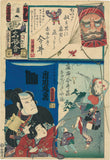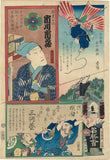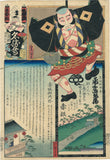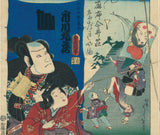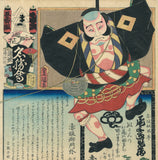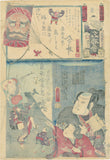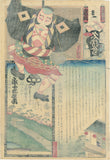Kunisada: Kite-Flying Triptych from Flowers of Edo (Sold)
Artist: Utagawa Kunisada (1786-1865) and Other Artists
Title: Complete Triptych Featuring Flying Kites
Series: Edo no hana meisho-e 江戸廼花名勝会 (Flowers of Edo and Views of Famous Places)
Date: 1863
Three kite-themed prints from this interesting series that form a triptych. Lower left, next to the actor Ichikawa Kuzo II, who holds the spool for the kite string, a young boy early holds the bottom end of a kite string that stretches across all three sheets. To the right, we see the kite itself, flying in the sky. The kite is a portrait of the actor Onoe Tamizo II in the role of Akasaka yakko Takohei. The right sheet is so dominated by the kite figure that the other two panels in the work are gentle landscapes. In the middle we see two figures by Kyosai at bottom, rushing to the right, one with his hands up in alarm. The second figure holds a drum. Also in the middle sheet is a man who has become tangled in a large kite and seems to be falling to the ground; perhaps we was caught atop a roof? In the middle sheet we see the actor Ichikawa Ichizo holding a large bell and looking towards the rightmost sheet. He grasps some sort of signpost. On the left sheet we see three kites in the sky, the largest being the stern visage of Shoki, the Demon Queller, a popular figure that is displayed often on Boys Day. The sky around him features sparkling mica. The portion in lower right features a kite falling from the sky and hitting a shamisen musician as she walks, throwing her off balance. This humorous part was done by the young Yoshitoshi.
At left is Ichikawa Kuzo II in the role of Imai Shiro Kanehira, from the Shi Brigade, Fifth Group. Right is No Ma Akasaka with the actor Onoe Tamizo II in the role of Akasaka yakko Takohei. Middle is No Ma Mikawadai, lower portion by Kyosai with the actor Ichikawa Ichizo at left.
Artists: Kunisada, Kiyokuni, Yoshitoshi (left); Kunisada, Kyosai, Shunkai (middle); Kunisada, Hiroshige II (right).
This series gives new meaning to the word “collaboration.” The term used in the title, “flowers of Edo” (Edo no hana), can also refer to that most common of catastrophes, fires. Each title panel shows the lanterns and identifying standard (matoi) for one of the brigades of firefighters (hikeshi) that were assigned to each district. On the west side of the Sumida River were 48 brigades named for the symbols of the kana syllabary and grouped into 8 numbered groups. On the east side of the river, brigades were numbered and assigned to directional groups. Outlying districts were covered by special brigades, here designated “extra” (bangai). Each title gives the name or number of a brigade, its group, and its district, followed by the kabuki scene chosen to reflect the place. In general, Kunisada designed the actor portrait and various (21! in total for the series) other artists designed the landscape scenes.
Condition: Excellent impression, color and condition.
Dimensions: Three-panel print (each sheet approx 35.5 x 24.3 cm)
Publisher: Katôya Iwazoô (Seibei)
Literature: See MFA website. Seal: Blockcutter: Horikô Ryûzô
Signature: Toyokuni ga
SKU: KUS527












